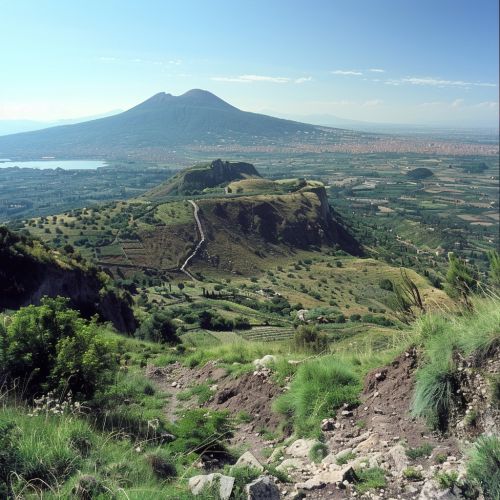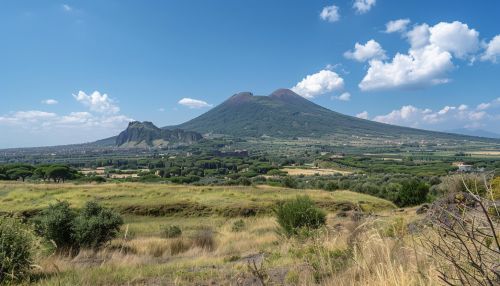Mount Vesuvius
Introduction
Mount Vesuvius is a stratovolcano located on the Gulf of Naples in Campania, Italy. It is one of the most well-known volcanoes in the world due to its violent eruption in 79 AD, which led to the destruction of the Roman cities of Pompeii and Herculaneum. The volcano is the only one in mainland Europe to have erupted within the last hundred years and is regarded as one of the most dangerous volcanoes in the world due to its proximity to the densely populated city of Naples.


Geology
Mount Vesuvius is a complex stratovolcano, which means it is composed of many layers of hardened lava, tephra, pumice, and volcanic ash. This type of volcano is characterized by periodic explosive eruptions and quiet eruptions of lava. The volcano is part of the Campanian volcanic arc, a line of volcanoes that formed over a subduction zone created by the convergence of the African and Eurasian plates.
The volcano's structure consists of a large cone (Gran Cono) that has been built up by numerous eruptions within a caldera-like structure known as Mount Somma. This older, collapsed volcano was the height of the current Vesuvius until a major eruption caused it to collapse, creating a caldera, and the current cone began to grow within it.
The magma in the volcano is classified as viscous and acidic, which contributes to the explosiveness of the eruptions. The viscosity of the magma prevents gases from escaping, which leads to a build-up of pressure that is released in an explosive manner.
History
The history of Mount Vesuvius is long and storied, with its most famous eruption occurring in 79 AD. This eruption is particularly well-known due to the accounts of Pliny the Younger, a Roman author and administrator who provided a first-hand account of the event. The eruption resulted in the destruction of the Roman cities of Pompeii and Herculaneum, killing thousands of people and burying the cities under a thick layer of volcanic ash.
The volcano has erupted many times since then, with the most recent eruption occurring in 1944. This eruption destroyed several villages and caused extensive damage to the surrounding areas. Despite the danger it poses, the fertile volcanic soils make the region an attractive place for agriculture, particularly the cultivation of grapes for the production of the famous Lacryma Christi wine.
Current Status and Monitoring
Today, Mount Vesuvius is closely monitored by the Vesuvius Observatory and other international geological agencies. The volcano is currently dormant, with its last eruption occurring in 1944. However, due to its explosive history and location near populated areas, it is considered one of the most dangerous volcanoes in the world.
The Vesuvius Observatory monitors seismic activity, gas emissions, and ground deformation at the volcano. It uses this data to assess the likelihood of an eruption. In the event of significant changes, the Observatory would provide early warning to the local population and authorities.
Impact on Local Population
The presence of Mount Vesuvius has a significant impact on the local population. The fertile volcanic soils support a thriving agriculture industry, particularly the cultivation of grapes for wine production. However, the threat of an eruption is a constant concern. The Italian government has a plan in place to evacuate up to 600,000 people from the Red Zone, the area most at risk from a major eruption.
Despite the potential danger, the area around Vesuvius is heavily populated. The city of Naples and several smaller towns are located within the danger zone. The volcano and the ruined cities of Pompeii and Herculaneum are also major tourist attractions, drawing millions of visitors each year.
